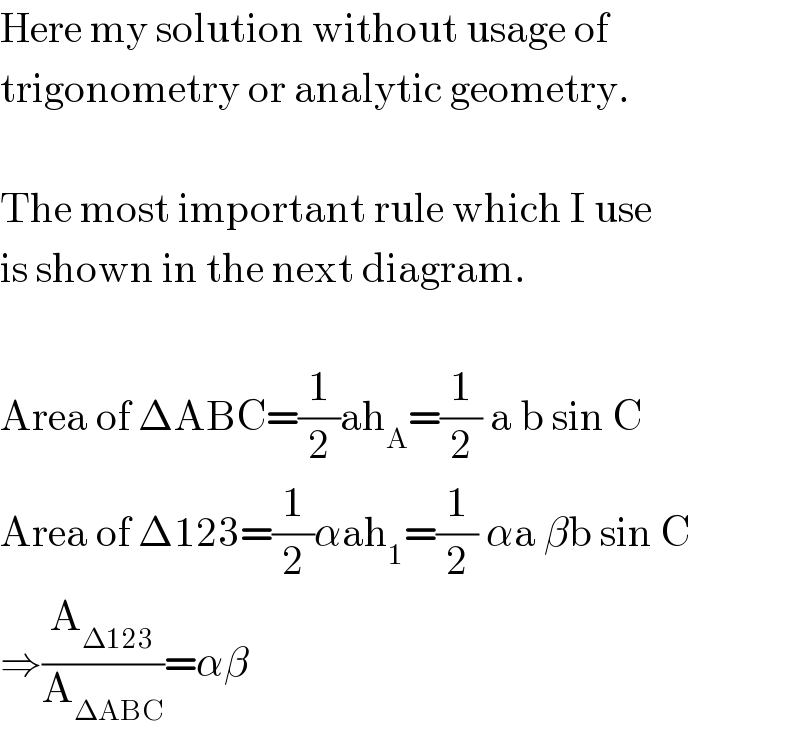
Question Number 14940 by mrW1 last updated on 05/Jun/17

$${For}\:{those}\:{who}\:{are}\:{interested}\:{in}\: \\ $$$${Geometry}:\: \\ $$$${A}\:{triangle}\:{has}\:{an}\:{area}\:{of}\:\mathrm{1}\:{unit}.\:{Each} \\ $$$${of}\:{its}\:{sides}\:{is}\:{divided}\:{into}\:\mathrm{4}\:{equal}\:{parts} \\ $$$${through}\:\mathrm{3}\:{points}.\:{The}\:{first}\:{and}\:{the}\:{last} \\ $$$${point}\:{of}\:{each}\:{side}\:{will}\:{be}\:{connected} \\ $$$${with}\:{each}\:{other}\:{to}\:{form}\:\mathrm{2}\:{inscribed} \\ $$$${triangles}\:{and}\:{these}\:\mathrm{2}\:{triangles}\:{form} \\ $$$${a}\:{hexagon}.\:{Find}\:{the}\:{area}\:{of}\:{the}\:{hexagon}. \\ $$$$ \\ $$$${What}\:{is}\:{the}\:{result},\:{if}\:{each}\:{side}\:{is} \\ $$$${equally}\:{divided}\:{into}\:\mathrm{5}\:{parts},\:{or} \\ $$$${generally}\:{into}\:{n}\:{parts}? \\ $$
Commented by mrW1 last updated on 05/Jun/17

Commented by b.e.h.i.8.3.4.1.7@gmail.com last updated on 06/Jun/17

Commented by mrW1 last updated on 06/Jun/17

$${you}\:{got}\:{X}=\frac{{n}\left({n}−\mathrm{1}\right)−\mathrm{3}}{{n}\left({n}−\mathrm{1}\right)} \\ $$$${and}\:{X}=\frac{\mathrm{1}}{\mathrm{2}}\:{by}\:{n}=\mathrm{3} \\ $$$${but}\:{the}\:{right}\:{answer}\:{is}\:{X}=\mathrm{2}/\mathrm{9}\:{by}\:{n}=\mathrm{3} \\ $$
Commented by mrW1 last updated on 06/Jun/17

$${error}\:{in}\:{your}\:{working}\:\left({I}\:{think}\right): \\ $$$$\mathrm{2}\left({S}−{X}\right)\neq\frac{\mathrm{6}{S}}{{n}\left({n}−\mathrm{1}\right)}\Rightarrow{X}\neq{S}−\frac{\mathrm{3}{S}}{{n}\left({n}−\mathrm{1}\right)} \\ $$
Commented by ajfour last updated on 06/Jun/17

$${could}\:{it}\:{be}\:=\frac{\mathrm{49}}{\mathrm{160}}\:? \\ $$
Commented by mrW1 last updated on 06/Jun/17

$$\frac{\mathrm{49}}{\mathrm{160}}\:{for}\:{n}=\mathrm{4}\:{is}\:{correct},\:{congratulation}! \\ $$
Commented by ajfour last updated on 06/Jun/17

$${thank}\:{you}\:{Sir},\:{this}\:{question}\:{of} \\ $$$${yours}\:{let}\:{me}\:{learn}\:{triangular} \\ $$$${coordinates}\:{all}\:{by}\:{myself}.. \\ $$
Commented by mrW1 last updated on 06/Jun/17

$${I}\:{devised}\:{this}\:{question}.\:{That}\:{you}\:{got} \\ $$$${the}\:{right}\:{answer}\:{in}\:{such}\:{a}\:{short}\:{time} \\ $$$${shows}\:{that}\:{you}\:{have}\:{learnt}\:{quite}\:{a}\:{lot}. \\ $$
Commented by mrW1 last updated on 06/Jun/17

$$\mathrm{This}\:\mathrm{question}\:\mathrm{can}\:\mathrm{be}\:\mathrm{solved}\:\mathrm{with}\:\mathrm{basic} \\ $$$$\mathrm{geometry}\:\mathrm{knowledge}.\:\mathrm{It}\:\mathrm{is}\:\mathrm{not}\:\mathrm{necessary} \\ $$$$\mathrm{to}\:\mathrm{use}\:\mathrm{trigonometry}\:\mathrm{or}\:\mathrm{analytic}\:\mathrm{geometry}. \\ $$
Commented by mrW1 last updated on 06/Jun/17

$$\mathrm{To}\:\mathrm{Behi}'\mathrm{s}\:\mathrm{father}:\:\mathrm{you}\:\mathrm{are}\:\mathrm{very}\:\mathrm{close}\:\mathrm{at} \\ $$$$\mathrm{the}\:\mathrm{final}\:\mathrm{solution}.\:\mathrm{I}'\mathrm{m}\:\mathrm{sure}\:\mathrm{you}'\mathrm{ll}\:\mathrm{be}\:\mathrm{able} \\ $$$$\mathrm{to}\:\mathrm{get}\:\mathrm{the}\:\mathrm{general}\:\mathrm{solution}\:\mathrm{for}\:\mathrm{case}\:\mathrm{n}. \\ $$
Commented by b.e.h.i.8.3.4.1.7@gmail.com last updated on 07/Jun/17

$${S}_{\mathrm{1}} =\frac{\mathrm{1}}{\mathrm{2}}.\frac{{b}}{{n}}.\frac{{n}−\mathrm{1}}{{n}}.{c}.{sinA}=\frac{{n}−\mathrm{1}}{{n}^{\mathrm{2}} }.{S} \\ $$$${S}_{\mathrm{1}} ^{'} =\frac{\mathrm{1}}{\mathrm{2}}.\frac{{b}'}{\mathrm{3}}.\frac{{c}'}{\mathrm{3}}.{sinA}'=\frac{{S}'}{\mathrm{9}} \\ $$$${S}'={S}−\mathrm{3}×\frac{{n}−\mathrm{1}}{{n}^{\mathrm{2}} }{S}=\frac{{n}^{\mathrm{2}} −\mathrm{3}{n}+\mathrm{3}}{{n}^{\mathrm{2}} }{S} \\ $$$${S}'_{\mathrm{1}} =\frac{{S}'}{\mathrm{9}}=\frac{{n}^{\mathrm{2}} −\mathrm{3}{n}+\mathrm{3}}{\mathrm{9}{n}^{\mathrm{2}} } \\ $$$${S}_{{hexagon}} ={S}'−\mathrm{3}{S}'_{\mathrm{1}} =\left(\frac{{n}^{\mathrm{2}} −\mathrm{3}{n}+\mathrm{3}}{{n}^{\mathrm{2}} }−\mathrm{3}×\frac{{n}^{\mathrm{2}} −\mathrm{3}{n}+\mathrm{3}}{\mathrm{9}{n}^{\mathrm{2}} }\right){S}= \\ $$$$=\frac{\mathrm{2}\left({n}^{\mathrm{2}} −\mathrm{3}{n}+\mathrm{3}\right)}{\mathrm{3}{n}^{\mathrm{2}} }.{S} \\ $$$${for}:{n}=\mathrm{3}\Rightarrow{S}_{{h}} =\frac{\mathrm{2}×\mathrm{3}}{\mathrm{3}×\mathrm{9}}.{S}=\frac{\mathrm{2}}{\mathrm{9}}.{S} \\ $$
Commented by mrW1 last updated on 07/Jun/17

$$\mathrm{please}\:\mathrm{check}\:\mathrm{again}: \\ $$$$\mathrm{for}\:\mathrm{n}=\mathrm{4},\:\mathrm{the}\:\mathrm{right}\:\mathrm{answer}\:\mathrm{should}\:\mathrm{be} \\ $$$$\mathrm{S}_{\mathrm{h}} =\frac{\mathrm{49}}{\mathrm{160}}\mathrm{S}\:\left(\mathrm{as}\:\mathrm{Mr}.\:\mathrm{ajfour}\:\mathrm{evaluated}\right) \\ $$$$ \\ $$$$\mathrm{I}\:\mathrm{think}\:\mathrm{there}\:\mathrm{is}\:\mathrm{an}\:\mathrm{error}\:\mathrm{here}: \\ $$$${S}'_{\mathrm{1}} \neq\frac{{S}'}{\mathrm{9}}\:\left(\mathrm{this}\:\mathrm{is}\:\mathrm{only}\:\mathrm{true}\:\mathrm{for}\:\mathrm{the}\:\mathrm{case}\:\mathrm{n}=\mathrm{3}\right) \\ $$
Answered by ajfour last updated on 07/Jun/17

$$\:\frac{{Area}_{{hexagon}} }{{Area}_{\bigtriangleup} }\:=\frac{\mathrm{2}\left(\boldsymbol{{n}}^{\mathrm{2}} −\mathrm{3}\boldsymbol{{n}}+\mathrm{3}\right)^{\mathrm{2}} }{\boldsymbol{{n}}^{\mathrm{3}} \left(\mathrm{2}\boldsymbol{{n}}−\mathrm{3}\right)}\:. \\ $$
Commented by mrW1 last updated on 07/Jun/17

$$\mathrm{your}\:\mathrm{answer}\:\mathrm{is}\:\mathrm{correct}\:\mathrm{and}\:\mathrm{you}\:\mathrm{have} \\ $$$$\mathrm{used}\:\mathrm{a}\:\mathrm{different}\:\mathrm{way}\:\mathrm{as}\:\mathrm{I}\:\mathrm{originally} \\ $$$$\mathrm{expected}.\:\mathrm{you}\:\mathrm{applied}\:\mathrm{analytic}\:\mathrm{geometry}. \\ $$$$\mathrm{this}\:\mathrm{is}\:\mathrm{nice}\:\mathrm{and}\:\mathrm{easy},\:\mathrm{because}\:\mathrm{you} \\ $$$$\mathrm{don}'\mathrm{t}\:\mathrm{need}\:\mathrm{any}\:\mathrm{tricks}. \\ $$$$\mathrm{but}\:\mathrm{as}\:\mathrm{I}\:\mathrm{said}\:\mathrm{one}\:\mathrm{can}\:\mathrm{also}\:\mathrm{get}\:\mathrm{the}\:\mathrm{result} \\ $$$$\mathrm{without}\:\mathrm{analytic}\:\mathrm{geometry}\:\mathrm{or}\:\mathrm{trigonometry}. \\ $$
Commented by mrW1 last updated on 07/Jun/17

$$\mathrm{x}=\mathrm{0}.\mathrm{222}\:\mathrm{for}\:\mathrm{n}=\mathrm{3} \\ $$$$\mathrm{x}=\mathrm{0}.\mathrm{306}\:\mathrm{for}\:\mathrm{n}=\mathrm{4} \\ $$$$\mathrm{x}\rightarrow\mathrm{1}\:\mathrm{when}\:\mathrm{n}\rightarrow\infty \\ $$$$\mathrm{the}\:\mathrm{hexagon}\:\mathrm{gets}\:\mathrm{bigger}\:\mathrm{and}\:\mathrm{bigger} \\ $$$$\mathrm{with}\:\mathrm{increasing}\:\mathrm{n} \\ $$
Answered by mrW1 last updated on 08/Jun/17

$$\mathrm{Here}\:\mathrm{my}\:\mathrm{solution}\:\mathrm{without}\:\mathrm{usage}\:\mathrm{of} \\ $$$$\mathrm{trigonometry}\:\mathrm{or}\:\mathrm{analytic}\:\mathrm{geometry}. \\ $$$$ \\ $$$$\mathrm{The}\:\mathrm{most}\:\mathrm{important}\:\mathrm{rule}\:\mathrm{which}\:\mathrm{I}\:\mathrm{use} \\ $$$$\mathrm{is}\:\mathrm{shown}\:\mathrm{in}\:\mathrm{the}\:\mathrm{next}\:\mathrm{diagram}.\: \\ $$$$ \\ $$$$\mathrm{Area}\:\mathrm{of}\:\Delta\mathrm{ABC}=\frac{\mathrm{1}}{\mathrm{2}}\mathrm{ah}_{\mathrm{A}} =\frac{\mathrm{1}}{\mathrm{2}}\:\mathrm{a}\:\mathrm{b}\:\mathrm{sin}\:\mathrm{C} \\ $$$$\mathrm{Area}\:\mathrm{of}\:\Delta\mathrm{123}=\frac{\mathrm{1}}{\mathrm{2}}\alpha\mathrm{ah}_{\mathrm{1}} =\frac{\mathrm{1}}{\mathrm{2}}\:\alpha\mathrm{a}\:\beta\mathrm{b}\:\mathrm{sin}\:\mathrm{C} \\ $$$$\Rightarrow\frac{\mathrm{A}_{\Delta\mathrm{123}} }{\mathrm{A}_{\Delta\mathrm{ABC}} }=\alpha\beta \\ $$
Commented by mrW1 last updated on 08/Jun/17

Commented by mrW1 last updated on 08/Jun/17

Commented by mrW1 last updated on 08/Jun/17

$$\mathrm{Each}\:\mathrm{side}\:\mathrm{of}\:\mathrm{triangle}\:\Delta\mathrm{ILG}\:\mathrm{is}\:\mathrm{equally} \\ $$$$\mathrm{divided}\:\mathrm{into}\:\mathrm{n}\:\mathrm{parts}.\:\mathrm{n}\geqslant\mathrm{3}. \\ $$$$\mathrm{Let}\:\mathrm{a}=\frac{\mathrm{LG}}{\mathrm{n}}=\mathrm{length}\:\mathrm{of}\:\mathrm{each}\:\mathrm{part}\:\mathrm{of}\:\mathrm{LG} \\ $$$$\mathrm{Let}\:\mathrm{us}\:\mathrm{say}\:\mathrm{the}\:\mathrm{area}\:\mathrm{of}\:\mathrm{triangle}\:\Delta\mathrm{ILG} \\ $$$$\mathrm{is}\:\mathrm{S}=\mathrm{1}. \\ $$$$ \\ $$$$\mathrm{According}\:\mathrm{to}\:\mathrm{the}\:\mathrm{rule}\:\mathrm{above}\:\mathrm{we}\:\mathrm{have} \\ $$$$\mathrm{A}_{\Delta\mathrm{ACG}} =\frac{\mathrm{n}−\mathrm{1}}{\mathrm{n}}×\frac{\mathrm{1}}{\mathrm{n}}×\mathrm{S}=\frac{\mathrm{n}−\mathrm{1}}{\mathrm{n}^{\mathrm{2}} } \\ $$$$=\mathrm{A}_{\Delta\mathrm{CHI}} =\mathrm{A}_{\Delta\mathrm{NAL}} \\ $$$$=\mathrm{A}_{\Delta\mathrm{BML}} =\mathrm{A}_{\Delta\mathrm{MHI}} =\mathrm{A}_{\Delta\mathrm{HBG}} \\ $$$$ \\ $$$$\Rightarrow\mathrm{A}_{\Delta\mathrm{MHB}} =\mathrm{A}_{\Delta\mathrm{AHG}} =\mathrm{S}−\mathrm{3}×\mathrm{A}_{\Delta\mathrm{ACG}} \\ $$$$=\mathrm{1}−\mathrm{3}×\frac{\mathrm{n}−\mathrm{1}}{\mathrm{n}^{\mathrm{2}} }=\frac{\mathrm{n}^{\mathrm{2}} −\mathrm{3n}+\mathrm{3}}{\mathrm{n}^{\mathrm{2}} } \\ $$$$\mathrm{To}\:\mathrm{get}\:\mathrm{the}\:\mathrm{area}\:\mathrm{of}\:\mathrm{the}\:\mathrm{hexagon}\:\mathrm{we}\:\mathrm{now} \\ $$$$\mathrm{only}\:\mathrm{need}\:\mathrm{to}\:\mathrm{get}\:\mathrm{the}\:\mathrm{area}\:\mathrm{of}\:\mathrm{the}\:``\mathrm{red}'' \\ $$$$\mathrm{as}\:\mathrm{well}\:\mathrm{as}\:\mathrm{the}\:``\mathrm{black}''\:\mathrm{small}\:\mathrm{triangles}. \\ $$
Commented by mrW1 last updated on 08/Jun/17

$$\mathrm{Using}\:\mathrm{the}\:\mathrm{rule}\:\mathrm{above}\:\mathrm{we}\:\mathrm{have} \\ $$$$\mathrm{A}_{\Delta\mathrm{ACB}} =\frac{\mathrm{n}−\mathrm{2}}{\mathrm{n}}×\frac{\mathrm{1}}{\mathrm{n}}×\mathrm{S}=\frac{\mathrm{n}−\mathrm{2}}{\mathrm{n}^{\mathrm{2}} } \\ $$$$\mathrm{To}\:\mathrm{get}\:\mathrm{the}\:\mathrm{area}\:\mathrm{of}\:\mathrm{A}_{\Delta\mathrm{DEB}} \:\mathrm{we}\:\mathrm{need}\:\mathrm{to} \\ $$$$\mathrm{know}\:\mathrm{how}\:\mathrm{the}\:\mathrm{line}\:\mathrm{segment}\:\mathrm{AC}\:\mathrm{is} \\ $$$$\mathrm{divided}\:\mathrm{by}\:\mathrm{points}\:\mathrm{D}\:\mathrm{and}\:\mathrm{E}. \\ $$
Commented by mrW1 last updated on 08/Jun/17

Commented by mrW1 last updated on 08/Jun/17
![We introduce some auxiliary lines: CK parallel to IF CJ parallel to HB ΔCJG is similar to ΔHBG ⇒((JG)/(BG))=((CG)/(HG)) ⇒JG=((CG)/(HG))×BG=(1/(n−1))×BG=(a/(n−1)) ΔKCG is similar to ΔFIG ⇒((KG)/(FG))=((CG)/(IG)) ⇒KG=((CG)/(IG))×FG=(1/n)×((LG)/2)=(1/n)×((na)/2)=(a/2) ΔADF is similar to ΔACK ⇒((AD)/(AF))=((AC)/(AK)) ⇒AD=((AF)/(AK))×AC=((LF−LA)/(AG−KG))×AC =((((na)/2)−a)/(na−a−(a/2)))×AC=((n−2)/(2n−3))×AC ΔAEB is similar to ΔACJ ⇒((AE)/(AC))=((AB)/(AJ)) ⇒AE=((AB)/(AJ))×AC=((AB)/(AG−JG))×AC =((na−2a)/(na−a−(a/(n−1))))×AC=((n−1)/n)×AC DE=AE−AD=((n−1)/n)×AC−((n−2)/(2n−3))×AC =(((n−1)/n)−((n−2)/(2n−3)))×AC =(((n−1)(2n−3)−n(n−2))/(n(2n−3)))×AC =((n^2 −3n+3)/(n(2n−3)))×AC Using our rule abov we get A_(ΔDEB) =((DE)/(AC))×A_(ΔACB) =((n^2 −3n+3)/(n(2n−3)))×((n−2)/n^2 )=(((n^2 −3n+3)(n−2))/(n^3 (2n−3))) Area of hexagon: A_H =A_(ΔMHB) −3×A_(ΔDEB) A_H =((n^2 −3n+3)/n^2 )−3×(((n^2 −3n+3)(n−2))/(n^3 (2n−3))) =((n^2 −3n+3)/n^2 )[1−((3(n−2))/(n(2n−3)))] =((n^2 −3n+3)/n^2 )[((n(2n−3)−3(n−2))/(n(2n−3)))] =((n^2 −3n+3)/n^2 )[((2n^2 −6n+6)/(n(2n−3)))] =((2(n^2 −3n+3)^2 )/(n^3 (2n−3)))](Q15247.png)
$$\mathrm{We}\:\mathrm{introduce}\:\mathrm{some}\:\mathrm{auxiliary}\:\mathrm{lines}: \\ $$$$\mathrm{CK}\:\mathrm{parallel}\:\mathrm{to}\:\mathrm{IF} \\ $$$$\mathrm{CJ}\:\mathrm{parallel}\:\mathrm{to}\:\mathrm{HB} \\ $$$$ \\ $$$$\Delta\mathrm{CJG}\:\mathrm{is}\:\mathrm{similar}\:\mathrm{to}\:\Delta\mathrm{HBG} \\ $$$$\Rightarrow\frac{\mathrm{JG}}{\mathrm{BG}}=\frac{\mathrm{CG}}{\mathrm{HG}} \\ $$$$\Rightarrow\mathrm{JG}=\frac{\mathrm{CG}}{\mathrm{HG}}×\mathrm{BG}=\frac{\mathrm{1}}{\mathrm{n}−\mathrm{1}}×\mathrm{BG}=\frac{\mathrm{a}}{\mathrm{n}−\mathrm{1}} \\ $$$$ \\ $$$$\Delta\mathrm{KCG}\:\mathrm{is}\:\mathrm{similar}\:\mathrm{to}\:\Delta\mathrm{FIG} \\ $$$$\Rightarrow\frac{\mathrm{KG}}{\mathrm{FG}}=\frac{\mathrm{CG}}{\mathrm{IG}} \\ $$$$\Rightarrow\mathrm{KG}=\frac{\mathrm{CG}}{\mathrm{IG}}×\mathrm{FG}=\frac{\mathrm{1}}{\mathrm{n}}×\frac{\mathrm{LG}}{\mathrm{2}}=\frac{\mathrm{1}}{\mathrm{n}}×\frac{\mathrm{na}}{\mathrm{2}}=\frac{\mathrm{a}}{\mathrm{2}} \\ $$$$ \\ $$$$\Delta\mathrm{ADF}\:\mathrm{is}\:\mathrm{similar}\:\mathrm{to}\:\Delta\mathrm{ACK} \\ $$$$\Rightarrow\frac{\mathrm{AD}}{\mathrm{AF}}=\frac{\mathrm{AC}}{\mathrm{AK}} \\ $$$$\Rightarrow\mathrm{AD}=\frac{\mathrm{AF}}{\mathrm{AK}}×\mathrm{AC}=\frac{\mathrm{LF}−\mathrm{LA}}{\mathrm{AG}−\mathrm{KG}}×\mathrm{AC} \\ $$$$=\frac{\frac{\mathrm{na}}{\mathrm{2}}−\mathrm{a}}{\mathrm{na}−\mathrm{a}−\frac{\mathrm{a}}{\mathrm{2}}}×\mathrm{AC}=\frac{\mathrm{n}−\mathrm{2}}{\mathrm{2n}−\mathrm{3}}×\mathrm{AC} \\ $$$$ \\ $$$$\Delta\mathrm{AEB}\:\mathrm{is}\:\mathrm{similar}\:\mathrm{to}\:\Delta\mathrm{ACJ} \\ $$$$\Rightarrow\frac{\mathrm{AE}}{\mathrm{AC}}=\frac{\mathrm{AB}}{\mathrm{AJ}} \\ $$$$\Rightarrow\mathrm{AE}=\frac{\mathrm{AB}}{\mathrm{AJ}}×\mathrm{AC}=\frac{\mathrm{AB}}{\mathrm{AG}−\mathrm{JG}}×\mathrm{AC} \\ $$$$=\frac{\mathrm{na}−\mathrm{2a}}{\mathrm{na}−\mathrm{a}−\frac{\mathrm{a}}{\mathrm{n}−\mathrm{1}}}×\mathrm{AC}=\frac{\mathrm{n}−\mathrm{1}}{\mathrm{n}}×\mathrm{AC} \\ $$$$ \\ $$$$\mathrm{DE}=\mathrm{AE}−\mathrm{AD}=\frac{\mathrm{n}−\mathrm{1}}{\mathrm{n}}×\mathrm{AC}−\frac{\mathrm{n}−\mathrm{2}}{\mathrm{2n}−\mathrm{3}}×\mathrm{AC} \\ $$$$=\left(\frac{\mathrm{n}−\mathrm{1}}{\mathrm{n}}−\frac{\mathrm{n}−\mathrm{2}}{\mathrm{2n}−\mathrm{3}}\right)×\mathrm{AC} \\ $$$$=\frac{\left(\mathrm{n}−\mathrm{1}\right)\left(\mathrm{2n}−\mathrm{3}\right)−\mathrm{n}\left(\mathrm{n}−\mathrm{2}\right)}{\mathrm{n}\left(\mathrm{2n}−\mathrm{3}\right)}×\mathrm{AC} \\ $$$$=\frac{\mathrm{n}^{\mathrm{2}} −\mathrm{3n}+\mathrm{3}}{\mathrm{n}\left(\mathrm{2n}−\mathrm{3}\right)}×\mathrm{AC} \\ $$$$ \\ $$$$\mathrm{Using}\:\mathrm{our}\:\mathrm{rule}\:\mathrm{abov}\:\mathrm{we}\:\mathrm{get} \\ $$$$\mathrm{A}_{\Delta\mathrm{DEB}} =\frac{\mathrm{DE}}{\mathrm{AC}}×\mathrm{A}_{\Delta\mathrm{ACB}} \\ $$$$=\frac{\mathrm{n}^{\mathrm{2}} −\mathrm{3n}+\mathrm{3}}{\mathrm{n}\left(\mathrm{2n}−\mathrm{3}\right)}×\frac{\mathrm{n}−\mathrm{2}}{\mathrm{n}^{\mathrm{2}} }=\frac{\left(\mathrm{n}^{\mathrm{2}} −\mathrm{3n}+\mathrm{3}\right)\left(\mathrm{n}−\mathrm{2}\right)}{\mathrm{n}^{\mathrm{3}} \left(\mathrm{2n}−\mathrm{3}\right)} \\ $$$$ \\ $$$$\mathrm{Area}\:\mathrm{of}\:\mathrm{hexagon}: \\ $$$$\mathrm{A}_{\mathrm{H}} =\mathrm{A}_{\Delta\mathrm{MHB}} −\mathrm{3}×\mathrm{A}_{\Delta\mathrm{DEB}} \\ $$$$\mathrm{A}_{\mathrm{H}} =\frac{\mathrm{n}^{\mathrm{2}} −\mathrm{3n}+\mathrm{3}}{\mathrm{n}^{\mathrm{2}} }−\mathrm{3}×\frac{\left(\mathrm{n}^{\mathrm{2}} −\mathrm{3n}+\mathrm{3}\right)\left(\mathrm{n}−\mathrm{2}\right)}{\mathrm{n}^{\mathrm{3}} \left(\mathrm{2n}−\mathrm{3}\right)} \\ $$$$=\frac{\mathrm{n}^{\mathrm{2}} −\mathrm{3n}+\mathrm{3}}{\mathrm{n}^{\mathrm{2}} }\left[\mathrm{1}−\frac{\mathrm{3}\left(\mathrm{n}−\mathrm{2}\right)}{\mathrm{n}\left(\mathrm{2n}−\mathrm{3}\right)}\right] \\ $$$$=\frac{\mathrm{n}^{\mathrm{2}} −\mathrm{3n}+\mathrm{3}}{\mathrm{n}^{\mathrm{2}} }\left[\frac{\mathrm{n}\left(\mathrm{2n}−\mathrm{3}\right)−\mathrm{3}\left(\mathrm{n}−\mathrm{2}\right)}{\mathrm{n}\left(\mathrm{2n}−\mathrm{3}\right)}\right] \\ $$$$=\frac{\mathrm{n}^{\mathrm{2}} −\mathrm{3n}+\mathrm{3}}{\mathrm{n}^{\mathrm{2}} }\left[\frac{\mathrm{2n}^{\mathrm{2}} −\mathrm{6n}+\mathrm{6}}{\mathrm{n}\left(\mathrm{2n}−\mathrm{3}\right)}\right] \\ $$$$=\frac{\mathrm{2}\left(\mathrm{n}^{\mathrm{2}} −\mathrm{3n}+\mathrm{3}\right)^{\mathrm{2}} }{\mathrm{n}^{\mathrm{3}} \left(\mathrm{2n}−\mathrm{3}\right)} \\ $$
Commented by b.e.h.i.8.3.4.1.7@gmail.com last updated on 08/Jun/17

$${Great}\:{job}\:{done}\:{mrW}\mathrm{1}.{fantastic}. \\ $$$${I}\:{love}\:{this}\:{proof}\:{very}\:{much}. \\ $$
Commented by b.e.h.i.8.3.4.1.7@gmail.com last updated on 08/Jun/17

$${after}\:{this}\:,{i}\:{am}\:{waiting}\:{for}\:{mr} \\ $$$${Ajfour}'{s}\:{proof}\:{too}. \\ $$
